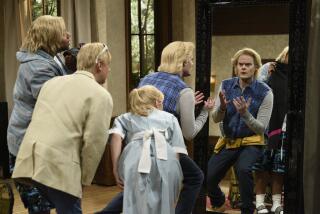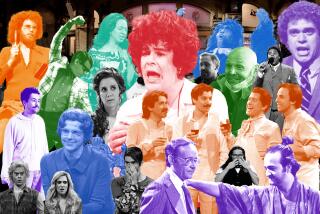The truth about fiction
The explosion of reality TV shows has changed the face of the entertainment business, not always in predictable ways. Some of the most creative people in Hollywood are jumping aboard this bandwagon in their own fashion, hatching television shows and movies that blur the line between truth and fiction. Instead of merely pandering to viewers’ voyeuristic impulses, they tease this bizarre craze.
“Curb Your Enthusiasm,” in which writer Larry David plays himself and skewers his own Hollywood lifestyle, is one of the quirkiest hits on the tube.
On the movie front, screenwriter Charlie Kaufman has helped refine this hybrid genre. In “Being John Malkovich” he persuaded Malkovich to play himself in a fanciful comedy about a group of losers who rejuvenate themselves by entering a portal into Malkovich’s body. In “Adaptation” Nicolas Cage played Kaufman, a suddenly hot screenwriter struggling with his next project. “Adaptation” took us behind the scenes of “Being John Malkovich” and played mind games by introducing the character of Charlie’s twin brother, Donald, who doesn’t exist.
“American Splendor” mixed documentary and drama by incorporating actors and real people; cartoonist Harvey Pekar and his wife kept popping up to comment on the actors playing them -- Paul Giamatti and Hope Davis.
Think of these as “reality shows” enlivened by a bracing touch of irony. This month three new movies push this trend further while they play arresting reality-illusion games. Jim Jarmusch’s “Coffee and Cigarettes,” which opened May 14, features a slew of showbiz personalities -- including Bill Murray, Cate Blanchett, Alfred Molina, British comic Steve Coogan, musicians Tom Waits and Iggy Pop, rappers GZA and RZA -- playing themselves in fictional skits.
“Frankie & Johnny Are Married,” which opened Wednesday, also boasts real people playing themselves, in a scenario that actually took place. The film recounts the misadventures that befell director Michael Pressman -- a veteran of TV shows such as “Picket Fences” and “Chicago Hope” -- when he decided to mount a local stage production of Terrence McNally’s romantic drama, “Frankie and Johnny in the Clair de Lune,” as a showcase for his wife, actress Lisa Chess. When her leading man freaked out during rehearsals, Pressman took over the costar role. In the movie Pressman and Chess play themselves, while Alan Rosenberg impersonates the troubled costar, who has not been identified.
Another insider’s extravaganza, Mario Van Peebles’ “Baadasssss!” (which opened Friday), re-creates the filming of “Sweet Sweetback’s Baadasssss Song,” an indie film directed by Mario’s father, Melvin Van Peebles, in 1971. Mario plays his father and Khleo Thomas plays young Mario.
Once upon a time, such inside-Hollywood dramas would have seemed far too specialized to attract a general audience. But times have changed, and these movies reflect the new appetite for reality-tinged entertainment as well as the increasing obsession with show business. Today people in Duluth follow weekend grosses and know the inside dope about Michael Moore’s squabbles with Disney.
Writing what they know
Hollywood people satirizing their own fetishes and follies isn’t new. Radio and TV shows half a century ago featured Jack Benny, George Burns and Gracie Allen playing themselves and lampooning their personalities. Several of Billy Wilder’s movies contained elaborate inside jokes. “Sunset Boulevard” cast Gloria Swanson as a faded silent movie star not unlike herself, and director Cecil B. DeMille appeared in the movie as Cecil B. DeMille (who had directed Swanson in several of her early silent pictures).
These shows and movies worked because their creators were often at their most biting and inspired when writing about the world they knew firsthand. The new movies confirm the continuing vitality of Hollywood’s brand of navel-gazing.
In envisioning “Coffee and Cigarettes,” a group of shorts shot over a number of years and knitted into a feature, Jarmusch wrote the script with specific actors and musicians in mind. “They were delighted to riff off their own qualities and make fun of themselves,” Jarmusch reports.
For example, Blanchett enjoyed playing two roles -- herself and a jealous cousin. “Both characters have elements of Cate,” Jarmusch says. When her cousin gleefully tells her that she saw a nasty tabloid article about her, Blanchett responds by asking, “What was I wearing?”
“Cate told me that was the kind of thing she would say, so she added that line to the scene,” Jarmusch says.
In one of the other episodes, Coogan plays himself as a self-infatuated star who lords it over Molina. “Steve is actually not arrogant at all,” Jarmusch says, “but he loves playing characters with flaws that are cringingly embarrassing. That’s what he does on his TV show in England. These sketches are completely fictitious, but they incorporate little bits of truth about the actors.”
The real and the semi-real
In the case of “Frankie & Johnny Are Married,” Pressman originally wrote the script using fictitious characters, but he decided that the stakes didn’t seem high enough, so he rewrote it using real names. He also decided to enlist some Hollywood colleagues -- CBS chief Leslie Moonves, producer David E. Kelley and “Chicago Hope” star Mandy Patinkin -- to play themselves in cameo roles.
The principals in the film found it stimulating to turn themselves into semi-fictional characters. “I took the opportunity to poke fun at myself and ridicule some of my own issues in life,” Pressman says.
For example, during the chaotic theater production depicted in the film, Pressman sometimes seems like a wimp trying to placate his wife and her increasingly erratic costar. “I am a bit of a mediator and a peacemaker,” Pressman admits. “That’s my Achilles’ heel.”
On the other hand, there were aspects of the character that were not so close to him. When he is finally pushed to the breaking point in the film, Pressman flies into a rage. “It was fun to unleash that because I don’t usually behave that way.”
Similarly, his wife says the Lisa Chess depicted in the film shares her name but not all of her characteristics. “I come off as so pragmatic in the film. I am pragmatic, that’s true. But I have a wilder side. I’m a bit more of a gambler than the film suggests.”
Mario Van Peebles’ “Baadasssss!” has a different kind of voyeuristic kick -- the novelty of seeing Mario portray his father. He originally intended to cast another actor as Melvin, but when he couldn’t secure studio financing and had to cut the budget, the most economical strategy was to play the leading role himself.
“That’s exactly how my father ended up casting himself in ‘Sweetback’ 30 years ago,” Mario observes. The most controversial aspect of “Sweet Sweetback” was Melvin’s decision to use his 13-year-old son in some fairly explicit sex scenes. “Baadasssss!” gave Mario the opportunity to confront some personal issues by re-imagining the incident from the points of view of father and son.
In another example of history repeating, Mario cast his son in “Baadasssss!” as a ghetto angel in a fantasy scene. But on the day of shooting his big scene, technical problems delayed the filming and the younger Van Peebles walked off the set. Mario reports what happened next: “I heard a voice screaming, ‘Get back here!’ It was my dad’s voice, but he was in New York. My dad’s voice was coming out of my body. I guess I understood my dad better when I had to walk a mile in his shoes. He was fighting to hold the movie together.”
Melvin saw the movie for the first time at last year’s Toronto Film Festival. “It was surreal to sit next to my dad watching me playing him,” Mario says.
Are these movies therefore nothing more than vanity productions or therapeutic exercises for their creators? The evidence suggests otherwise. When they were shown at festivals, both “Baadasssss!” and “Frankie & Johnny” stirred enthusiastic audience response. Patrons chortled over the inside jokes and reveled in the knowing details.
Maybe the films work because contemporary audiences are savvier, but they also happen to be a lot more entertaining than so many purely fictional spectacles that leave viewers numb.
Reality can be overrated, but it does add a jolt of energy and wit to this year’s cinematic offerings.
More to Read
Only good movies
Get the Indie Focus newsletter, Mark Olsen's weekly guide to the world of cinema.
You may occasionally receive promotional content from the Los Angeles Times.










